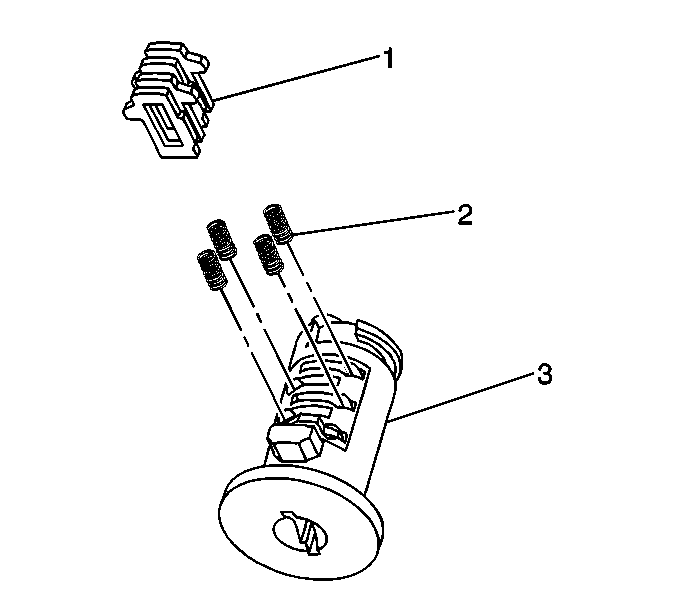Key Identification and Usage
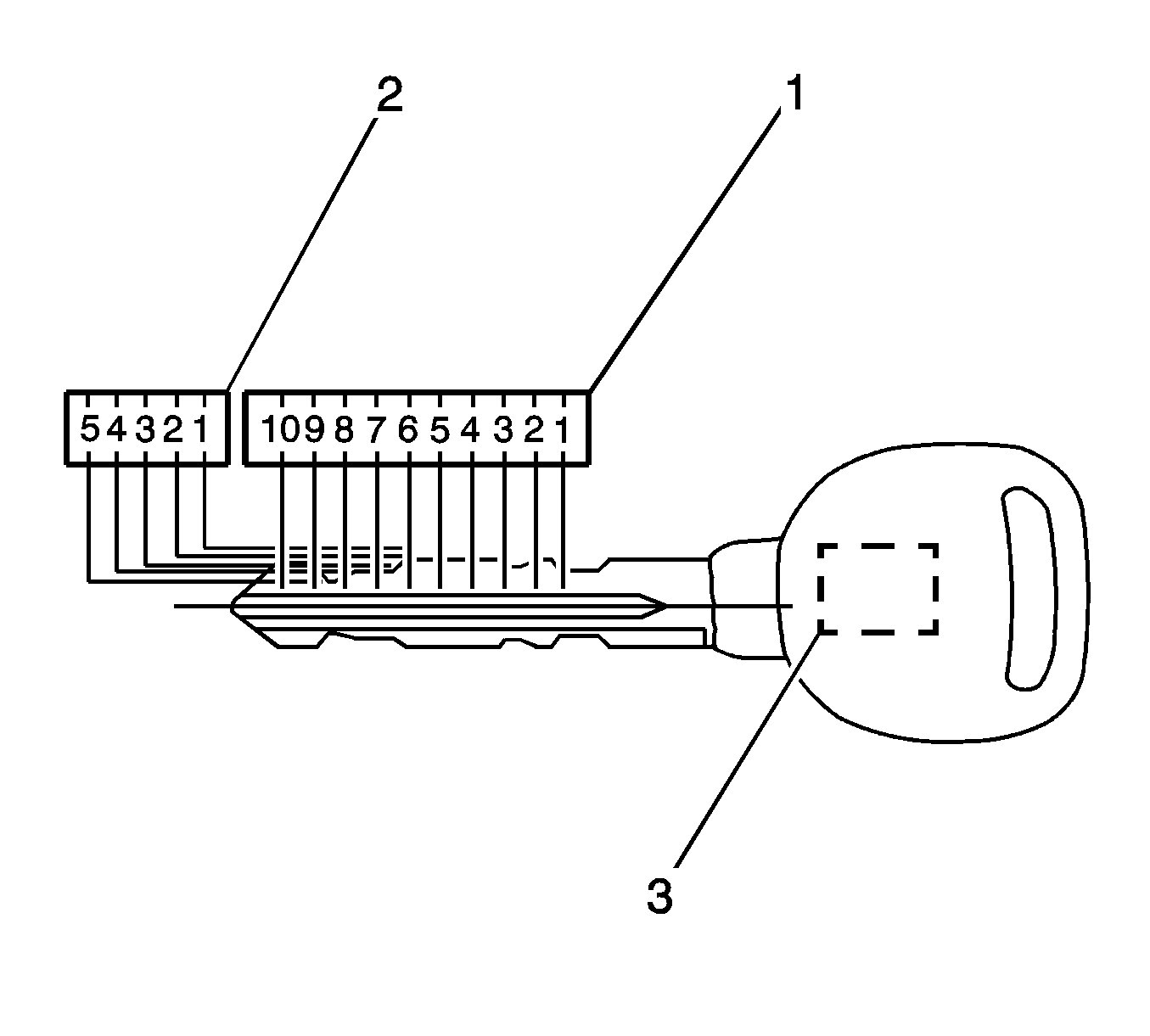
The keys are double sided and reversible. The master key and valet key contain transponders that are read by the theft deterrent system when the keys are used in the ignition. The keys have 10 cut positions (1) with 5 different depths (2).
The keys that are furnished with the vehicle are:
| • | The master key, which contains a transponder (3). This key will operate all of the locks on the vehicle. |
| • | The valet key, which contains a transponder (3). This key will operate the front door locks and the ignition lock only. |
| • | The emergency key, which does not contain a transponder. This key will operate the door locks, rear compartment lock and the instrument panel (I/P) storage compartment lock only. This key is intended for emergency use only. |
Cutting Keys

The key code can be obtained from the 5-digit number on the key tag that accompanies the original master and valet keys. The 5-digit key code cross references to the cut and tumbler sequence. The keys have 10 key cut positions (1) and 5 key cut depths (2). Key cut positions are numbered 1-10, counting from the head of the key to the tip. The key cut depths are 1-5, cut depth number 1 is the deepest cut. The key transponder (3) in the master and valet key must be programmed to the vehicle. Refer to Programming Theft Deterrent System Components .
- Cut a blank key to the proper depth and sequence of each of the tumbler positions.
- Inspect the mechanical operation of the key in the lock cylinders in the doors, the ignition switch, the rear compartment lid and any storage compartments:
- If replacing a master or valet key, program the key transponder to the vehicle. Refer to Programming Theft Deterrent System Components .
With each side of the key pointing up inside the lock, inspect the operation of the lock in both directions.
| • | Turn the key both directions in each lock cylinder. |
| • | Turn the key with each side of the key pointing upward in each lock cylinder. |
Lock Cylinder Tumbler Operation
Each of the 4 cut depths on the key has corresponding tumblers sometimes referred to as plates or wafers. The tumbler depth number is stamped on the tumblers for identification. The I/P storage compartment lock cylinder also require a retainer tumbler. The retainer tumbler is not moved by the key, its function is to retain the I/P storage compartment lock cylinder in the lock assembly.
Assembling and Coding Ignition Lock Cylinder
The ignition lock cylinder uses 7 of the 10 cut positions, 1 through 7. The tumbler positions are staggered from side to side, 4 on one side and 3 on the other.
- Hold the cylinder (7) so that the side with 4 tumbler spring wells is facing up.
- Insert tumbler springs (4) into the 5 spring wells.
- The first tumbler to be loaded will be the 1st key cut position the first number in the key code. Install the first tumbler (8) in the slot nearest the front of the lock cylinder, this is the side into which the key would be inserted.
- Install the 3 remaining tumblers on this side of the lock cylinder, key cut positions 3, 5, and 7.
- Inspect for correct loading of the tumblers (8) by inserting the key into cylinder (7). The tumblers (8) should be flush with the outside diameter of the cylinder (7).
- Turn the cylinder (7) so that the side with the 3 tumbler spring wells is facing up. Remove the key.
- Insert the tumbler springs (4) into the 3 spring wells.
- Install the tumbler (8) for the key cut position 2 into the slot nearest to the front of the lock cylinder.
- Install the 2 remaining tumblers, key cut positions 4 and 6 on this side of the lock cylinder.
- Inspect for correct loading of the tumblers (8) by inserting the key into cylinder (7). The tumblers (8) should be flush with the outside diameter of the cylinder (7).
- Lightly lubricate the tumbler (8) surfaces using the provided lubrication.
- With the key inserted into the housing, rotate the cylinder (7) so that the side with the 4 tumblers is facing up.
- Insert one retaining pin spring (3) and one retaining pin (2) into the hole located behind the 4 tumblers (8).
- Align the retaining lug on the cylinder (7) with the groove that extends the full length of the case assembly (1).
- With the retaining pin (2) full depressed, install the cylinder (7) into the case (1) until the retaining pin (2) enters the case assembly (1).
- Fully insert the cylinder (7), then rotate the cylinder (7) counter clockwise until the retaining pin snaps into place limiting the rotation.
- Remove the key and install the illumination ring (6) onto the case assembly (1).
- Install the theft deterrent module (5) over the illumination ring (6).
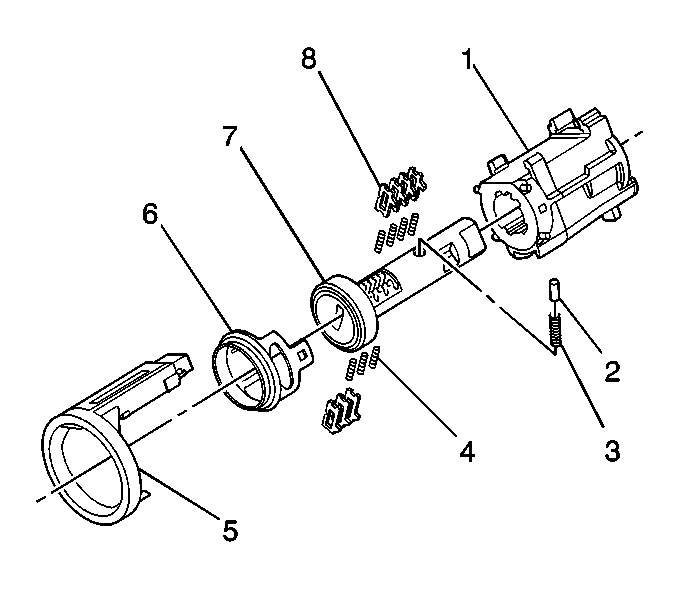
Important: The ignition lock cylinder tumblers (8) are not self retaining and must be held in place if the key is not fully inserted into the lock cylinder.
Caution: Wear safety glasses in order to avoid eye damage.
Important: The retaining pin spring (3) and retaining pin (2) are not self retaining and must be held in place until the cylinder (7) is assembled into the case assembly (1).
Assembling and Coding Door Lock Cylinder
The front side door lock cylinder only uses 7 of the 10 cut positions, 4 through 10. The tumbler positions are staggered from side to side 4 on one side and 3 on the other. The left and right door lock cylinders are identical. The lock pawl determines which side of the vehicle the lock cylinder is on.
- Hold the cylinder (9) so that the side with 4 tumbler spring wells faces up.
- Insert tumbler springs (5) into the 4 spring wells.
- Install the tumbler for key cut position 4 in the slot nearest to the front of the lock cylinder.
- Install the 3 remaining tumblers, key cut positions 6, 8 and 10, on this side of the lock cylinder.
- Inspect for correct loading of the tumblers (10) by inserting the key into cylinder (9). All of the tumblers should be flush with the outside diameter of the lock cylinder.
- Turn the cylinder (9) so that the side with 3 tumbler spring wells faces up.
- Insert the tumbler springs (5) into the 3 spring wells.
- Install the tumbler for key cut position 5 into the slot nearest the front of the lock cylinder.
- Install the 2 remaining tumblers for key cut positions 7 and 9 on this side of the lock cylinder.
- Inspect for correct loading of the tumblers (10) by inserting the key into cylinder (9). All of the tumblers should be flush with the outside diameter of the lock cylinder.
- Lightly lubricate the tumbler (10) surfaces using the provided lubrication.
- Hold the case assembly (11) with the pre-staked detent spring retainer facing downward.
- Insert one detent spring (3) and one detent ball (4) into the hole located to the rear and inside of the case assembly (11).
- Insert the key into the lock cylinder.
- Ensure the detent spring (3) and ball (4) are held in place until the cylinder is fully installed. Install the cylinder into the case assembly (11). The detent ball (4) will line up with the V-shaped groove on the rear of the cylinder.
- Carefully remove the key, keeping the lock cylinder (9) inserted into the case assembly (11).
- Insert one shutter spring (8) into each hole located on the front of the cylinder (9).
- Install the shutter assembly (7) into the recessed area in the front of the cylinder (9). Ensure the ends of the pin on the shutter assembly (7) are positioned in the pin cavities located on the front face of the cylinder (9).
- Install the lock cylinder cap (6) by aligning the 2 notches in the cap with the drain hole located on the bottom of the case assembly (11) and the corresponding feature on the top of the case assembly (11).
- Install the appropriate lever (2).
- Install the retaining ring (12).
- Snap the appropriate rod retainer (1) into the hole in the lever (2).
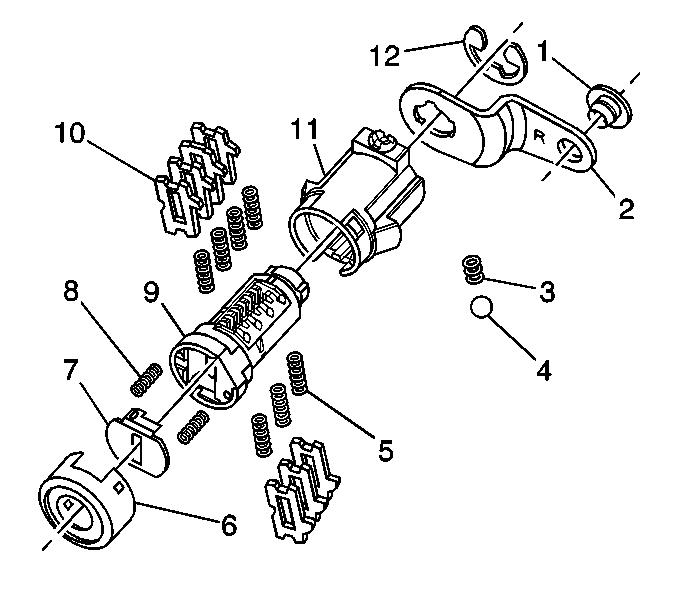
Important: The front side door lock cylinder tumblers (10) are not self retaining and must be held in place if the key is not fully inserted into the lock cylinder, or until the cylinder (9) is assembled into the case assembly (11).
Caution: Wear safety glasses in order to avoid eye damage.
Press the cap into place with light hand pressure.
Rear Compartment Lid Lock Cylinder
The rear compartment lid lock cylinder uses 8 of the 10 key cut positions, 3-10 when counting from the key head. The tumbler orientations alternate in adjacent locations from side to side with 4 on each side.
- Hold the uncoded cylinder (1) positioned so the side with the drain hole is facing downward.
- Insert one tumbler spring (2) each into the 4 tumbler spring holes.
- The first tumbler to be loaded will be key cut position number 3, the third number in the key code. Determine the cut depth at this position and install the corresponding tumbler (3) into the tumbler slot nearest the front of the cylinder (1), the end where the key is inserted.
- In the same manner, determine the cut depth and corresponding tumbler and install the 3 remaining tumblers (3) into the tumbler slots located at key cut positions 5, 7, and 9.
- Check for correct loading by holding the tumblers (3) in position and fully inserting the matching key into the cylinder (1). All tumblers should be flush with the outside diameter of the cylinder.
- Rotate the cylinder (1) so that the side with the drain hole is facing upward and then remove the matching key. Remember the tumblers (3) are not self-retaining and must be held in place.
- Insert one tumbler spring (2) each into the 4 tumbler spring holes.
- The first tumbler to be loaded will be key cut position number 4. Determine the cut depth at this position and install the corresponding tumbler (3) into the open tumbler slot nearest the front of the cylinder.
- In the same manner, determine the cut depth and corresponding tumbler and install the 3 remaining tumblers into the tumbler slots located at key cut positions 6, 8, and 10.
- Check for correct loading by holding the tumblers (3) in position and fully inserting the matching key into the cylinder (1). All tumblers should be flush with the outside diameter of the cylinder.
- Lightly lubricate tumbler (3) surfaces using the lubrication provided.
- With the matching key fully inserted into the coded cylinder, install the coded cylinder into the case (4).
- Remove the matching key being careful to keep the coded cylinder (1) fully inserted into the case (4).
- Insert one shutter spring (5) each into the 2 shutter spring holes located on the front face of the cylinder (1).
- Install the shutter assembly (6) into the recessed area on the front face of the cylinder (1). Be sure that the ends of the pin on the shutter assembly are positioned in the pin cavities located in the front face of the cylinder.
- Stake the cap (7) onto the head of the case (4) by using the appropriate staking tool . Ensure proper orientation and set the cylinder assembly (14), (which includes the case (4), coded cylinder (1), shutter springs (5), and shutter assembly (6)) and the cap (7) into the staking cup (15) and clamp into vise. Remove any debris and install the cleaned staking ram (16) into staking cup (15) and with a dead blow hammer, hit the staking ram (16) with moderate force 2 or 3 times. Check to determine if cap is securely staked to the cylinder assembly (14). Repeat previous step until cap is securely staked to the cylinder assembly. Remove assembly from the staking cup (15). If necessary, insert the removal punch (17) into the opposite end of the staking cup and tap lightly. Confirm that the shutter springs (5) push the shutter assembly (6) up against the inside surface of the cap (7).
- Install the gasket (8) over the end of the cylinder assembly and slide it all the way up the case (4) until it seats behind the cap (7).
- Install the return spring (9) over the back end of the cylinder (1) with the straight hook facing the rear of the case (4). Engage the straight hook of the return spring with the hook feature on the rear of the case.
- Install the spacer (10) and lever (11) onto the end of the cylinder (1).
- Install the retaining ring (12) in the groove at the end of the cylinder (1) to secure the lever (11) to the cylinder. Engage the bent hook of the return spring (9) with the lever.
- Install the theft deterrent switch (13) onto the end of the cylinder (1) and snap the switch legs onto the case (4). Be sure the theft deterrent switch is engaged with the end of the cylinder and is securely attached to the case.
- Check the operation of the lock assembly. The return spring (9) should provide a counterclockwise snap back.
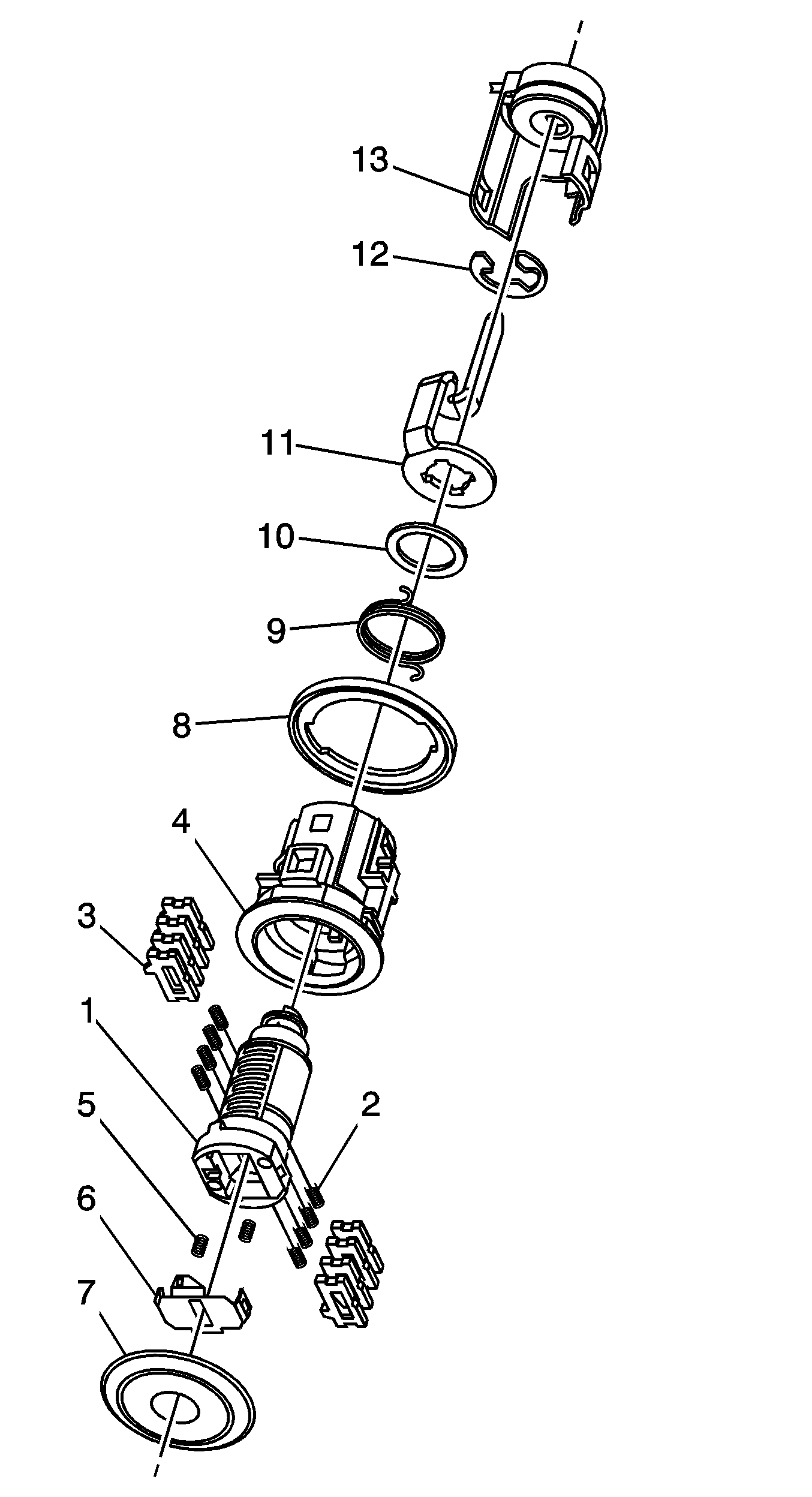
Important: The rear compartment lid lock cylinder tumblers (3) are not self-retaining and must be held in place if the key is not fully inserted into the lock cylinder or until the cylinder (1) is assembled into the case (4).
Important: Be careful not to scratch or dent the cosmetic surface of the cap or damage the lock cylinder in any way while staking the cap.

Assembling and Coding I/P Storage Compartment Lock Cylinder
The I/P storage compartment lock only uses 4 of the 10 cut positions 7-10 . A retainer tumbler is used in the I/P storage compartment lock to retain the lock cylinder in the latch assembly. This retainer tumbler is not moved by the key. The retainer tumbler occupies the slot closest to the head of the I/P storage compartment lock cylinder and should come already installed in the cylinder.
- Hold the cylinder (3) so that the side with 4 tumbler spring wells is facing up.
- Insert tumbler springs (2) into the 4 spring wells.
- Install the tumbler (1) for key cut position 7 into the slot nearest to the front of the lock cylinder.
- Install the 3 remaining tumblers, key cut positions 8, 9 and 10, into the cylinder.
- Snap the tumblers into place with light hand pressure.
- Inspect for the correct loading of the tumblers (1) by inserting the key into cylinder (3). All of the tumblers should be flush with the lock cylinder.
